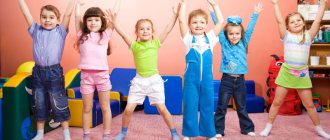To create a complex of outdoor educational equipment for children of the primary and middle groups for physical education classes in preschool educational institutions.
Outdoor switchgear for the second junior group
Outdoor switchgear complex without objects No. 1.
1. “Show me your hands”
IP: standing, legs slightly apart, hands behind your back.
Issue: “Where are our hands?”, “Here!” - bring your hands forward, etc. Pov: 4-5 times.
2. “Small are big”
IP: the same, hands down.
Ex: rise on your toes, arms up, stretch, - “That’s how big we are”; sit down, put your hands on your knees, - “That’s how small we are” Pov: 4-6 times.
3. “Show your knees”
I.p.: standing, hands on the belt.
Issue: “Where are the knees?” lean forward, touch your knees with your hands, “Here!”, etc.
Pov: 4-5 times.
4. “Whose legs?”
I.p.: sitting, legs straight, arms resting behind.
Issue: “Whose legs?”, “Mine”, bend your legs at the knees, clasp your arms, etc. Pov: 4-5 times.
5. “How legs can jump”
Jumping on two legs, alternate with breathing exercises or walking.
Outdoor switchgear of the middle group
Outdoor switchgear complex No. 1.
1. Head tilts
I.p.: standing, feet shoulder-width apart, hands on the belt. 1-tilt the head to the right (left), 2-i.p. Pov:4-6 times
2. Side bends
I.p.: the same, hands to shoulders. 1- tilt to the right (left), lower the right (left) hand down, 2- i.p. Pov: 4-6 times.
3. Bends down
I. p.: the same. 1- tilt down, reach the floor with your hands, 2-p. Pov: 5 times.
4. “We play with our toes”
I.p.: sitting on the floor, legs together, hands resting behind. Alternately raise and lower your toes.
5. "Bicycle"
IP: lying on your elbows. Rotational movements of the legs.
6. "Turn around"
IP: sitting on the floor in a cross, hands to shoulders. 1-turn right (left), right (left) hand back, look, 2-p. Pov: 4-6 times.
7. Jumping legs together - legs apart.
Alternate with breathing exercises or walking.
EXAMINATION TICKET No. 10
1. Forms of organization of physical education in preschool educational institutions The main forms of physical exercise are: morning exercises, lesson-type classes, outdoor games, physical education breaks and physical education minutes, physical education holidays, independent classes.
1. Morning exercises are aimed at activating the body’s activity, increasing its performance and forming correct posture. The remedies are simple general developmental exercises in combination with water procedures, massage, and hardening. Its duration is 5 minutes for children from 2 - 4 years old (3 - 4 exercises of a playful and imitative nature), 6 - 8 minutes for children 4 - 5 years old, 8 - 10 minutes - for children 6 years old. 2. Lesson-type physical education classes are the main form of work with children from 3 to 6 years old in kindergarten. The purpose of the classes is to teach new movements, consolidate previously mastered actions, and develop physical abilities. Classes are held at least 2-3 times a week under the guidance of a teacher. Duration of classes for children 3 - 4 years old 15 - 20 minutes, 4 - 5 years old - 20 - 25 minutes, 5 - 6 years old - 25 - 30 minutes. The classes consist of three parts: introductory (preparatory), main and final. The objectives of the introductory part are to organize the children, concentrate their attention on the upcoming motor exercises, and also prepare the body to perform the exercises of the main part. The content of the introductory part includes exercises in basic movements: walking, running, walking on toes, on heels, walking and running with a change of direction, snake walking, walking between objects, etc. The main part of the lesson solves the problem of teaching children new exercises, repetition and consolidation of previously covered material and the development of physical qualities. General developmental exercises are performed first in the main part (first for the muscles of the arms and shoulder girdle, then for the muscles of the torso and legs). After the ORU there are exercises in basic movements (walking, running, jumping, climbing, throwing or balance exercises). The main part of the lesson necessarily includes outdoor play, which enhances the physiological and emotional impact on children. In the final part of the lesson, the tasks of a gradual transition of the child’s body to a calm physiological state are solved. To gradually reduce the load, the following are used: walking, attention tasks, breathing exercises, sedentary games, round dances. 3. Outdoor games with a variety of motor content are carried out daily, usually during walks. Outdoor games often involve walking, running, jumping, crawling and other methods of movement. 4. Physical education breaks and physical education minutes 5. Physical education holidays . They are carried out at least 2 – 3 times a year. 6. Independent exercise . The varied independent motor activity of children lies in the fact that, at their own request and initiative, they choose the type of activity (riding a bicycle, physical activity on playgrounds equipped with special equipment for physical exercise and inventory, various games with friends, etc.) .


